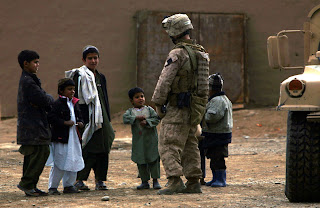 Date written: Feb. 18, 2009
Date written: Feb. 18, 2009Story by Lance Cpl. Ronald W. Stauffer
CAMP BARBER, Islamic Republic of Afghanistan – The first platoon of Battery D, 2nd Battalion, 14th Marine Regiment, test-fired its first rocket in-country from a High Mobility Artillery Rocket System at Camp Barber, Islamic Republic of Afghanistan, Feb. 15, 2009.
The El Paso, Texas-based Marine Corps Reserve battery conducted a full-scale fire mission scenario, proving it’s fully capable of firing and hitting its target within minutes and with deadly accuracy.

“I thought it went extremely well, and it was good to see the Marines receive the fruits of their labor,” said Maj. Frankie P. Delgado, the battery commander. “They did great and were on target.”
Within minutes, the battery was able to reach its firing point, set its rocket pod, receive coordinates, and deliver a global positioning system-aided rocket into a predetermined grid.
The battery’s mission is to support Special Purpose Marine Air Ground Task Force – Afghanistan as a fire support asset.
According to Delgado, the three-man crewed weapons system cradles six 200-pound rockets capable of destroying targets more than 70 kilometers away, striking with an accuracy up to an impressive eight meters.

Delgado said the battery is here to hit “higher value” targets, and the system can be used as an alternative to air strikes.
“We’re a great asset when you say you want to engage a particular target and not put innocent people in danger,” Delgado said. “We’re ready to take the fight to the enemy.”
Delgado said he sees the unit being a critical asset to SPMAGTF-A and in comparison to most air strikes, the enemy will never see the system’s rocket until it’s too late.
Although the Army has previously used the HIMARS in Afghanistan, the battery’s recent test-fire marked the first time the Marine Corps fired a HIMARS in Afghanistan, creating a page in the history books for the 150-Marine battery.

“We’ve been training for a long time, and we all wanted to do our job,” said Cpl. Luis A. Cardenas, a launcher chief with first platoon.
The Marine Corps designated 2/14 as a HIMARS unit in 2006, transitioning what was formerly an artillery-oriented battery from its howitzer cannons to the more advanced HIMARS.
“There’s no adjusting,” Delgado said. “You give us a grid, we’re going to hit that grid.”
The battery conducted three years of training in order to prepare for its receipt and use of the HIMARS and was called to active duty in October 2008. In November, the battery received notice to shift its focus toward Afghanistan.
“The weapons systems are 180 degrees apart from each other,” Delgado said, comparing the HIMARS to traditional howitzers. “It’s a new weapons system with GPS tracking. It’s like a scalpel versus a butcher knife.”
Delgado said just one of the HIMARS’ six rocket tubes can inflict the same amount of battle damage as one artillery cannon, but HIMARS has greater accuracy, mobility and less chance of being outside its target area.
Delgado also said some of the advantages of the systems are that they are transportable via C-130 cargo transport aircraft, lightweight and can get onto a road, drive to a point, fire and drive back before being detected.
“It’s (exciting) and it feels good,” Akin said. “For a reserve unit, I think it’s a good thing for the HIMARS to be in Afghanistan. Our Marines are always motivated and there’s a lot of pride.”
Akin said the battery has been at the camp for more than three weeks and was excited because they got to fire the system for the first time during the deployment.
“This is the tightest and most professional battery I’ve been with thus far, and it couldn’t have happened to a better group of guys,” Delgado said. “We are the fire support for SPMAGTF-A.”
Special Purpose Marine Air Ground Task Force – Afghanistan’s mission is to conduct counterinsurgency operations, with a focus on training and mentoring the Afghan National Police.






























